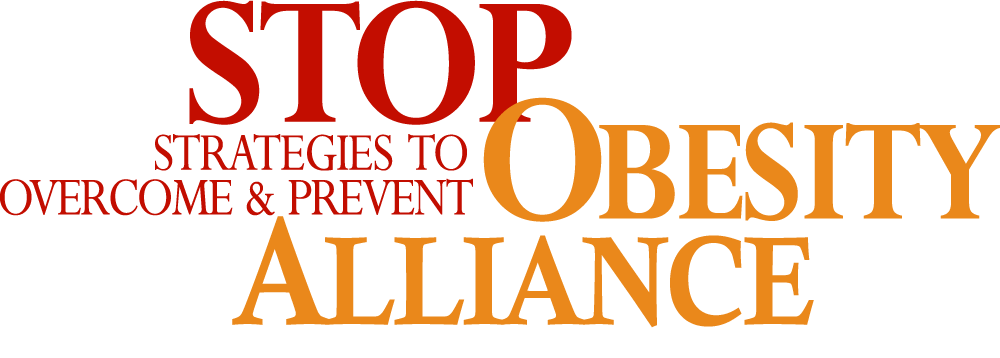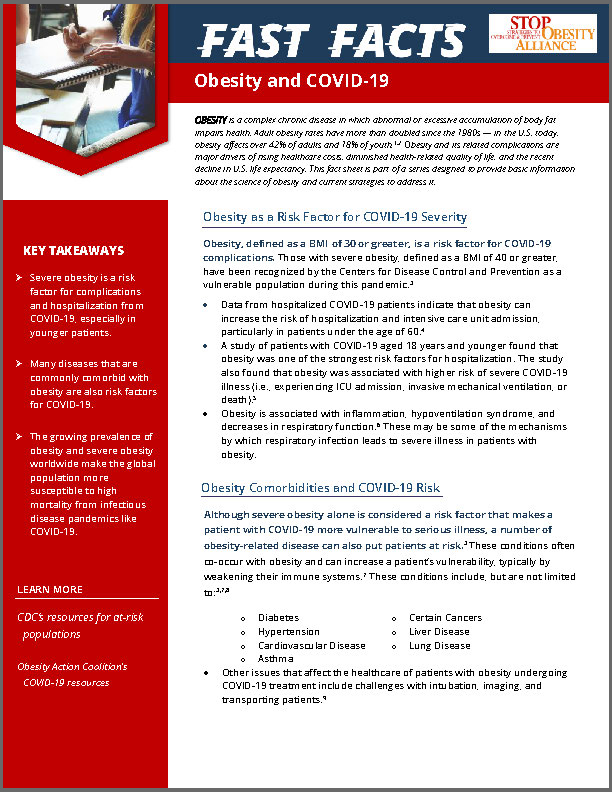Download: Fast Facts – Obesity and COVID-19
OBESITY is a complex chronic disease in which abnormal or excessive accumulation of body fat impairs health. Adult obesity rates have more than doubled since the 1980s — in the U.S. today, obesity affects over 42% of adults and 18% of youth.1,2 Obesity and its related complications are major drivers of rising healthcare costs, diminished health-related quality of life, and the recent decline in U.S. life expectancy. This fact sheet is part of a series designed to provide basic information about the science of obesity and current strategies to address it.
Key Takeaways
- Severe obesity is a risk factor for complications and hospitalization from COVID-19, especially in younger patients.
- Many diseases that are commonly comorbid with obesity are also risk factors for COVID-19.
- The growing prevalence of obesity and severe obesity worldwide make the global population more susceptible to high mortality from infectious disease pandemics like COVID-19.
Obesity as a Risk Factor for COVID-19 Severity
Obesity, defined as a BMI of 30 or greater, is now being considered a condition that can put patients at higher risk for COVID-19 complications. Those with severe obesity, defined as a BMI of 40 or greater, have been recognized by the Centers for Disease Control and Prevention as a vulnerable population during this pandemic.3 Data from hospitalized COVID-19 patients suggest that obesity can increase the risk of hospitalization and intensive care unit admission, particularly in patients under the age of 60.4
- Obesity is associated with inflammation, hypoventilation syndrome, and decreases in respiratory function.5 These may be some of the mechanisms by which respiratory infection leads to severe illness in patients with obesity.
- During the 2009 H1N1 flu pandemic, obesity was linked to higher rates of hospitalization, mechanical ventilation, and mortality.6
- COVID-19 appears to affect respiratory function in patients with obesity in the same way that H1N1 did. However more Americans are at risk of obesity-related complications during this pandemic, because obesity rates have risen significantly since 2009
- Due to the emerging data regarding severe COVID-19 illness and obesity, as well as the data from H1N1, healthcare providers treating COVID-19 patients with obesity should anticipate the probability of more severe illness in this population
Obesity Comorbidities and COVID-19 Risk
COVID-19 more vulnerable to serious illness, there are a number of obesity-related diseases that can also put patients at risk.3 These conditions often co-occur with obesity and can increase a patient’s vulnerability, typically by weakening their immune systems.7
- These conditions include, but are not limited to:3,7,8
- Diabetes
- Hypertension
- Cardiovascular Disease
- Asthma
- Certain Cancers
- Liver Disease
- Lung Disease
- Other issues that affect the healthcare of patients with obesity undergoing COVID-19 treatment include challenges with intubation, imaging, and transporting patients.9
Obesity and COVID-19
COVID-19 is currently estimated to result in 100,000-250,000 deaths in total.10 Obesity results in approximately 300,000 deaths annually.11
Obesity is among the chronic diseases that predispose patients with respiratory viruses to more severe disease progression.
Over half of adults with severe or fatal H1N1 in California were found to have obesity or severe obesity.12
The Pandemics of Obesity and COVID-19
Although COVID-19 is an infectious disease, the current pandemic highlights the importance of treating and preventing chronic diseases on a population level. The rising international rates of obesity, and its related comorbidities, have created a global population that is increasing susceptible to serious illness from novel infectious diseases.
- World obesity rates have risen to a record high with 13% of global citizens having a BMI of 30 or greater13 and are predicted to continue to increase.14 Obesity rates may rise more quickly than expected, especially among children, as school closures, stay-at-home orders, and social distancing measures influence many to stay sedentary indoors and rely on ultra-processed foods.15
- COVID-19 and obesity both have disproportionate impacts on racial and ethnic minorities. In the U.S., African American adults (47.9%) and Hispanic adults (44.8%) both have significantly higher rates of obesity than white adults (37.4%).16 Initial data show that racial and ethnic minorities have higher hospitalization and fatality rates related to COVID-19.17 These hospitalizations and deaths are not just attributable to obesity, but also a range of chronic illnesses that are more prevalent in these groups as a result of race-based discrimination and socioeconomic disparities.
- References
-
-
Hales CM, Carroll MD, Fryar CD, Ogden CL. Prevalence of obesity and severe obesity among adults: United States, 2017–2018. NCHS Data Brief, no 360. Hyattsville, MD: National Center for Health Statistics. 2020
-
Hales CM, Carroll MD, Fryar CD, Ogden CL. Prevalence of obesity among adults and youth: United States, 2015–2016. 2017.
-
People Who Are at Higher Risk for Severe Illness. Centers for Disease Control and Prevention. www.cdc.gov/coronavirus/2019-ncov/need-extra-precautions/groups-at-high…. Published April 17, 2020. Accessed April 22, 2020.
-
Lighter J, Phillips M, Hochman S, et al. Obesity in patients younger than 60 years is a risk factor for covid-19 hospital admission. Clin Infect Dis. 2020. https://doi.org/10.1093/cid/ciaa415.
-
Mafort TT, Rufino R, Costa CH, Lopes AJ. Obesity: Systemic and pulmonary complications, biochemical abnormalities, and impairment of lung function. Multidisciplinary Respiratory Medicine. 2016;11(1):28. https://doi.org/10.1186/s40248-016-0066-z.
-
Dietz W, Santos-Burgoa C. Obesity and its implications for COVID-19 mortality. Obesity. 2020; n/a. https://doi.org/10.1002/oby.22818.
-
Common Questions and Answers About COVID-19 for Older Adults and People with Chronic Health Conditions. National Foundation for Infectious Diseases. https://www.nfid.org/infectiousdiseases/common-questions-and-answers-ab…. Published April 17, 2020. Accessed April 23, 2020.
-
Associated Risks of Obesity. Rethink Obesity®. https://www.rethinkobesity.com/impact-of-obesity/associated-risks-of-ob…. Accessed April 22, 2020.
-
Coronavirus (COVID-19) & Obesity. World Obesity Federation. https://www.worldobesity.org/news/statement-coronavirus-covid-19-obesity. Published 2020. Accessed April 23, 2020.
-
White House Projects Grim Toll From Coronavirus. The New York Times. https://www.nytimes.com/2020/03/31/world/coronavirus-live-news-updates…. Published March 31, 2020. Accessed May 1, 2020.
-
Allison DB, Fontaine KR, Manson JE, Stevens J, VanItallie TB. Annual Deaths Attributable to Obesity in the United States. JAMA. 1999;282(16):1530–1538. doi:10.1001/jama.282.16.1530
-
Louie JK, Acosta M, Winter K, et al. Factors Associated With Death or Hospitalization Due to Pandemic 2009 Influenza A(H1N1) Infection in California. JAMA. 2009;302(17):1896–1902. doi:10.1001/jama.2009.1583
-
Obesity and overweight. World Health Organization. https://www.who.int/news-room/fact-sheets/detail/obesity-and-overweight. Published March 3, 2020. Accessed April 23, 2020.
-
Trends in adult body-mass index in 200 countries from 1975 to 2014: A pooled analysis of 1698 population-based measurement studies with 19·2 million participants. The Lancet. 2016;387(10026):1377-1396
-
Rundle AG, Park Y, Herbstman JB, Kinsey EW, Wang YC. COVID-19–Related school closings and risk of weight gain among children. Obesity. 2020; n/a. https://doi.org/10.1002/oby.22813.
-
HUS 2018 trend tables. Centers for Disease Control and Prevention. https://www.cdc.gov/nchs/data/hus/2018/026.pdf. Published 2018. Accessed April 29, 2020.
-
Yancy CW. COVID-19 and African Americans. JAMA. 2020. https://doi.org/10.1001/jama.2020.6548.
-
A product of the Strategies to Overcome & Prevent (STOP) Obesity Alliance at the Sumner M. Redstone Global Center for Prevention & Wellness.



